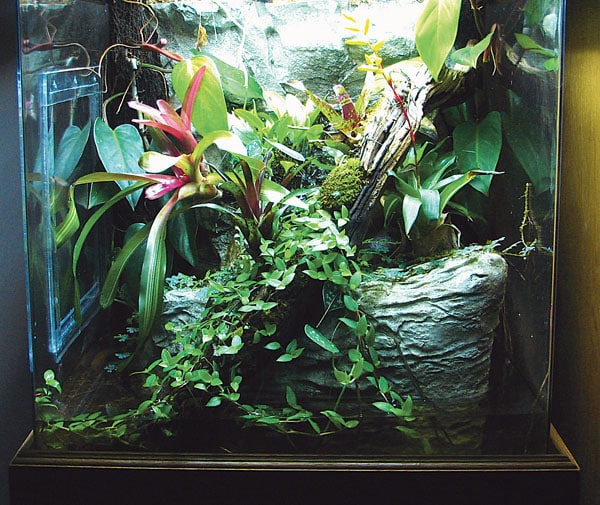Find the right enclosure for your next natural vivarium.
Many kinds of enclosures on the market can be used for reptiles and amphibians. What will work best for you largely depends on what you plan to keep in it and how much you’re willing to spend. This article reviews some commonly available cage types appropriate for a wide variety of herps. Any could be used to create the natural vivarium setup you’ve always wanted.
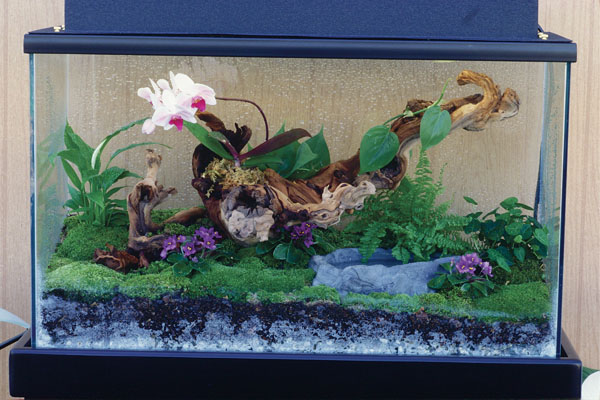
Glass tanks are a time proven standard.
Glass Reptile Enclosures
Glass herp tanks are a time-proven standard. Tanks with sliding screen tops are the most common, but there are also nice all-glass enclosures with front-opening doors, and they’re designed to accept most fixtures, such as lights, pump tubing and electrical cords.
A wide variety of glass tank sizes and styles are available. Sizes usually available on the shelf range from 10 to 55 gallons, but most companies can make much larger tanks. The most common configuration is a long, low rectangle. Tanks that are taller than long, or with extra width, or with front-opening doors are still less common, but they’re more available now than they used to be. If you don’t see what you want in a store, ask an employee whether the business’ supplier offers the style you need. If so, perhaps it can be ordered for you.
Also remember that if you have an animal with specific needs, some companies will make a custom tank at a fairly reasonable cost. Cost depends on which company your retailer deals with, and how different your tank will be relative to the kind they usually make. If the tank is not too unusual, the cost is usually not significantly different from a standard tank because material and labor costs are the same. More unusual tanks add up to greater cost. Larger sizes, complex (nonrectangular) tank shapes, extra doors, holes drilled for bulkheads or tubing, inclusion of nonstandard materials, etc., all add to the cost. Many reptile and pet shops can order custom tanks for you.
Because the screen tops of most reptile tanks allow sufficient air circulation and light penetration, they are good for all lizards from deserts or other dry, sunny environments. Many iguanids, agamids, lacertids and skinks are some examples. Many tortoises and snakes from arid environments also do well in these tanks.
Reptile Enclosures With Water Reservoir
For herpkeepers hoping to house aquatic or bog species, such as many amphibians, an aquarium works better than a reptile tank. Aquaria are usually sturdier and made of thicker glass, so they can better withstand water pressure. They’re also less likely to leak.
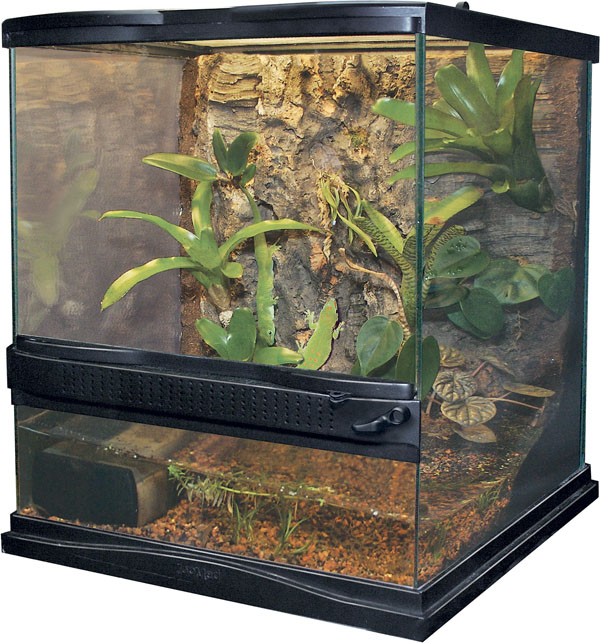
Courtesy Zoo Med Laboratories
A front-door glass terrarium is easily landscaped and retains heat and humidity. It also typically has convenient access points for cords, tubing, etc.
Aquaria come in a variety of styles and sizes similar to herp tanks. With aquaria, however, you are more likely to find standard nonrectangular styles, such as corner styles, bowed fronts and pre-drilled holes for bulkheads, available on the shelf. Of course, aquaria have only top openings. If a glass aquarium’s green tinge interferes with your desires, you might opt for an acrylic tank. These are crystal clear and not likely to be scratched by aquatic amphibians. Cost considerations for custom tanks are also similar to those for herp tanks.
Fitted with a screen top specifically made for use on aquaria, these enclosures are good for all aquatic amphibians, such as axolotls, sirens, and larval and breeding forms of many salamanders. Aquaria with glass tops, which hold in humidity, are good for many salamanders and tropical frogs that prefer high humidity, such as many poison frogs. If you place a screen enclosure atop an aquarium to make a combination enclosure, you will have room for emergent aquatic-bog plants and a wider range of amphibians.
Screen-vented Reptile Enclosures
Screen enclosures are another caging option. Providing plenty of fresh air, they can be useful for animals that are versatile regarding temperature and humidity. They also allow you to have a large enclosure that doesn’t weigh nearly as much as a glass tank would.
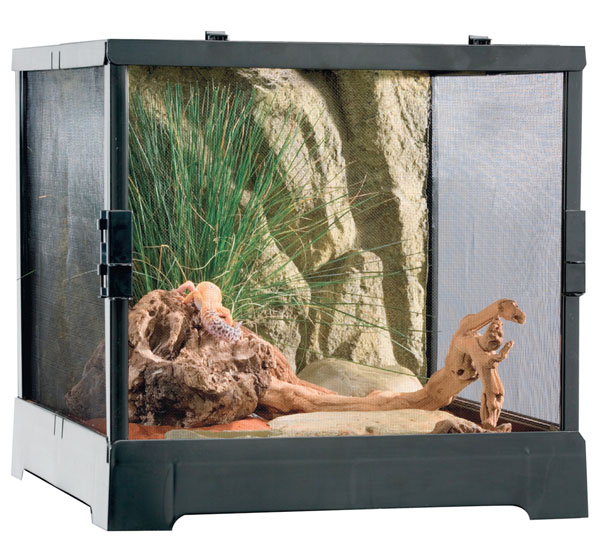
Photo courtesy Exo Terra
Lighter than a glass terrarium, a screen terrarium had good fresh-air flow.
Screen enclosures are available in sizes similar to those of glass tanks. However, because these cages are often used for arboreal species, most are vertically oriented. In addition to the all-screen models, styles are available with solid, waterproof bottoms, so you can landscape.
These enclosures are good for many chameleons, especially those from low-humidity areas, such as African dry bush lands, savannas and deserts, and the dry southern parts of Madagascar. Screen enclosures can also be good for arboreal lizards from low-humidity woodlands, such as tree lizards and some geckos. Many snakes also do well in these setups.
Consolidated Housing
Now combination enclosures are also available. Some screen enclosures are made to sit on top of glass tanks. This merger creates herp housing at least twice the size of either separate cage. Currently, these are available for 10-gallon, 20-gallon-long and 29-gallon tanks, but more sizes likely will be available in the future because they are so useful. Combination enclosures also allow separate microhabitats. The glass-tank area can be landscaped, contains messes and feeder insects, and provides slightly higher humidity, and the screen area allows space for larger plants, has good fresh-air circulation and can accept brighter, warmer lights without creating an excessively hot environment.
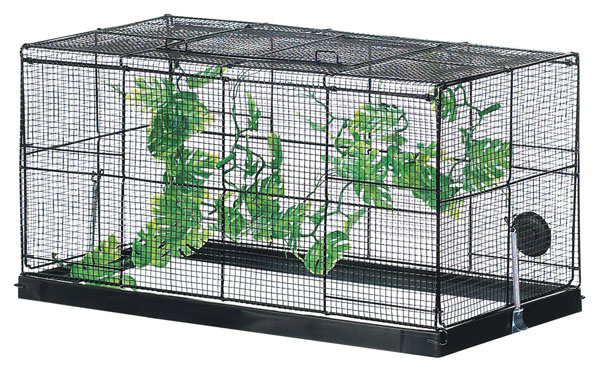
Image courtesy Zilla
Placed atop a glass aquaria or terraria, a screen enclosure top increases a vivarium's volume, allowing large plants and higher humidity in the tank with more fresh air in the screened area.
Combination enclosures are suitable for many chameleons and for treefrogs from temperate areas that need moisture but don’t like high humidity. These composite setups are also good for some poison frogs that don’t need high humidity and for some tropical treefrogs that come from drier areas, such as some monkey frogs (Phyllomedusa spp.). Many snakes, especially tree snakes from temperate, medium-humidity areas or less humid tropical areas, also do well in these enclosures.
Greenhouse Reptile Enclosure Options
Most enclosures discussed here are familiar to the majority of hobbyists. But many beautiful, desirable reptiles and amphibians have very specific needs that are difficult or impossible for most people to provide. For many of these demanding species, few good commercial enclosures are available. Serious collectors usually build their own enclosures.
Greenhouses are a great commercial option to successfully keep difficult species. Some you can order over the Internet and have delivered wherever you live. They come in a wide variety of styles and sizes from just a few square feet up to hundreds. A common hobby size is 50 to 80 square feet in configurations of 6 feet by 8 feet, 6 feet by 10 feet, 8 feet by 10 feet, etc. There are styles that attach to the side of your house or free-standing styles.
The space required for a greenhouse is only slightly more than the footprint of the house itself. Home-attached styles are the most space efficient. Set up is easy for almost anyone. Price depends on the brand — some are fancier than others — but you can easily get a 50-square-foot greenhouse for around $1,000. Many 50- to 100-square-foot houses go from $1,200 to $2,000. I’ve seen one large example measuring 16 feet by 30 feet for only about $3,000. If you’re going to spend money on a herp room or area with multiple tanks and fixtures anyway, it might make more sense to buy a greenhouse.
No matter what enclosure you buy for a vivarium, ask yourself the following six questions:
- Is the enclosure safe and secure? Make sure it is well-constructed and sturdy. There should be no rough or sharp edges or protrusions. Those inside might injure the animal. Those outside might injure you.
- Is the enclosure escapeproof? It needs a secure top or other access door without gaps where animals can squeeze through. Many reptile tanks have small spaces around the screen door or top, and people have lost small herps, such as serrated-tailed tree lizards (Holaspis spp.), geckos and small frogs, this way. Make sure the door or lid latches securely, so strong animals, such as snakes, can’t push it open.
- Can the enclosure maintain the required environmental conditions? If your animals and plants need high humidity, most of the vivarium should be made of glass or acrylic. If they need good air circulation, then you need screened areas. Sometimes it is difficult to achieve both high humidity and fresh-air circulation. You may have to experiment by covering some of the screen area until you get it right.
- Will the enclosure accommodate the appropriate fixtures? Some enclosures come with tops containing light fixtures, but these often don’t meet the needs of your animals and plants. If the included bulbs won’t provide the kind of light your vivarium needs, then buying an enclosure and an appropriate light fixture separately is best.
- Is the enclosure big enough? Its size and dimensions should meet your animal’s needs. Never force an animal to live in an enclosure that doesn’t provide enough space. Arboreal species need tall enclosures. Animals that like to run around need lots of floor space. Some animals also need an enclosure that is wide as well as long. For instance, instead of a tank measuring 5 feet long and 2 feet wide, they require one measuring 5 feet long and 3 feet wide.
- Will the enclosure meet aesthetic goals? If you’re purchasing it for strictly utilitarian purposes, then you probably aren’t too concerned about appearance. But if a display vivarium is what you’re after, and it will be in an area where people can enjoy it, you need to make sure the enclosure and its fixtures are attractive, and it allows easy viewing of the animals and landscaping.
These enclosures provide plenty of sunlight, which some reptiles need. By including appropriate cover, the animals can regulate their exposure as they wish. Greenhouses allow for spacious environments with large logs or trees, natural ground covers, or even a big pond. Accessories such as shade cloth, fans, swamp coolers, heaters and misters can help maintain the perfect temperature and humidity all year long. These are available from greenhouse suppliers and often at your local home-improvement store, which also has materials, such as screen, to cover openings and otherwise customize your greenhouse for reptiles and amphibians. You can set up all your tanks in a greenhouse, and they’ll get their light, heat and humidity without needing fixtures for each tank.
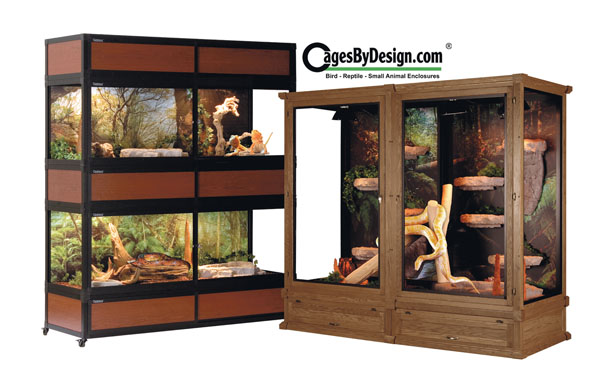
Image courtesy CagesByDesign
Enclosures for larger animals are also available.
Large reptiles such as monitors, iguanas, large chameleons and even crocodilians are great for a greenhouse. Many small herps, such as flying lizards (Draco spp.) and flying frogs (Rhacophorus spp.), also require lots of space and certain environmental fixtures to do well. Most don’t last long in captivity, but in a greenhouse, they can thrive and look beautiful. And many nonarboreal small lizards and other reptiles that need space to run don’t do well in small enclosures. Difficult collared lizards, for example, do fantastic in a dry greenhouse with scrubby plants and rock piles.
So the next time you set out to find the right enclosure for your natural vivarium, remember that what will work best — be it a glass reptile tank, aquarium, screen cage, combination enclosure or greenhouse — largely depends on what you plan to keep in it and how much you’re willing to spend. Happy hunting.

